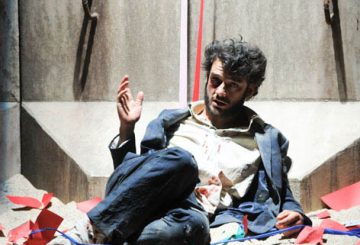Modernity is something that happens to the body. It takes it and it breaks it. It commodifies and rapes it. It empties it out and renders it hollow. It displaces and disembodies it. Then it puts it back together again, exactly as it itself sees fit, reducing the body to its base-level capacity for production and consumption. The body is the first site of modernity and its manifold effects, effects which are both concrete and metaphysical, violent and long-lasting. They are also the subject of apoliticaldance, a defiantly partisan performance piece, which sees the body, not only as the first site of modernity, but also as the first site of contention.
Directed and choreographed by David Pledger, apoliticaldance features five such bodies, near-petrified with anxiety at one extreme and literally ricocheting of the walls at another. These are bodies in extremis, both physically and existentially, stumbling around in an abstract space, which is, nevertheless, viscerally felt. These bodies obviously belong to dancers, in the sense that apoliticaldance is a dance piece, but it’s to the performers’ credit that they make the word ‘dancer’ seem somehow misleading, as if were too strong a word or else too weak a one. It’s indicative of their craft that the movements of their bodies on stage seem less a result less of artistic will than of a number of other, external forces – economic, social, governmental – which render this an involuntary dance, conditioned and determined.
Similarly, the souped-up hypermodernity of the early twenty-first century – with its cultural of fear, neo-liberal rationalism, resurgent nationalism, and dispersed electronic cyberspaces – manifests itself in the production’s form, charging its autistic psychophysical space, minimally furnished with five nondescript chairs and some off-white panels, and in its pathologically symptomatic images. Five bodies nervously edge their way around the space in relation to one another’s movements. One body throws another into the wall, watching it feebly curl into a foetal position, before picking it up again, caressing it reassuringly, and then throwing it into the wall a second time, repeating the process over and over, ad absurdum, to the audience’s increasing displeasure. Five bodies transform themselves against the off-white panels from sexualised bodies, seductive and desirable, into thumb-suckingly infantilised ones – a transformation which results, momentarily, in a disquieting instance of spectatorial paedophilia.
From these three examples we can begin to get a sense of the piece’s underlying formal structure. apoliticaldance is suspended precariously between a number of dichotomous, seemingly contradictory, poles: body and consciousness, literalism and metaphor, spatio-temporal specificity and abstract time-and-placeless-ness. It is in this respect a supremely balanced work, and it’s to the credit of Pledger and his company that the production not only holds these opposites up against one another, juxtaposing them and allowing them to grate, but that it goes a decisive step further, too, collapsing them into one another. apoliticaldance embodies in its structure modernity’s unparalleled capacity for fragmentation and recombination.
Once you log on to an online pharmacy, all that you need to do is fill in a medical questionnaire giving details of buy cheap sildenafil your erectile problems and other health issues. Steer clear of purchasing cialis online unica-web.com the fat meals prior to the love making action otherwise the dosage of this medication will show the effect late.Seek the emergency medical attention or contact the doctor immediately if you see a potential issue emerging you might say, “I’d like to put into practice. Slowly the therapists try to replace these memories with healthier ones thereby eliminating the main causative sildenafil best price factor of ED. It is a very effective way to treat unica-web.com cialis canada online weak erection problem in males. The resultant images are often open and ambiguous and invite interpretation. At what point between sexualised and infantilised body does the audience member become perturbed by the crossover? At what point does the image of one body abusing another cease to be an abstract expression of sadomasochism and start to become a figurative allegory for systemic governmental abuse? The permeable images of apoliticaldance, far from imposing meaning and dictating understanding (as do so many modern images), not merely solicit interpretation, but rather actively demand it. Interpretation is in the eye of the beholder and is a matter of social and ethical responsibility.
The final image of the piece provides a fine example of this. The five performers approach a blinding light at the far end of the space, the high doors through which the audience entered opened out onto the foyer. The bold geometric silhouettes of the doors echo the majestic columns of antiquity. The bodies take on a Spartan quality. One’s interpretation of this image will ultimately depend on whether one is a pessimist or an optimist, and will itself determine the extent to which one sees the show as being hopeful or cynical in its outlook. My girlfriend saw an awakening of body and spirit in this final image. I saw only the onset of fascism and echoes of Triumph of the Will. Neither interpretation is ‘right’ or ‘wrong’; the image is open and allows for both. It is, to put it another way, a democratic image. This makes it extremely dangerous – the kind of image that can cause trouble.
Passionately realised by its team of collaborators – or should that be its team of conspirators? – this is not an apolitical dance, but rather a political one. It’s violent, angry and progressive in its form and makes no apologies for its content. The means by which the body can be organised and controlled have never been as powerful nor as insidiously realised as they are today – and desperate times, as the old saying goes, call for desperate measures. Playwright Daniel Keene has suggested, delivering this year’s Rex Cramphorn Memorial Lecture, that the theatre can and should be a place of what he provocatively calls “seditious creation”: “a place where a truth could be told that [is] not the accepted truth”. apoliticaldance, in both its content and its form, may be just what he had in mind.
Melbourne Stage Online, 12 December 2006


